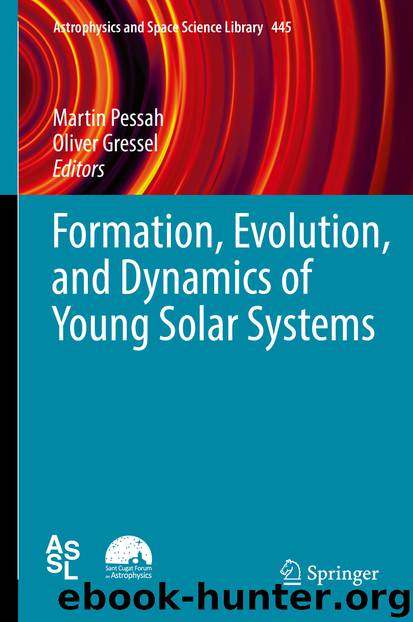Formation, Evolution, and Dynamics of Young Solar Systems by Martin Pessah & Oliver Gressel

Author:Martin Pessah & Oliver Gressel
Language: eng
Format: epub
Publisher: Springer International Publishing, Cham
Van Kooten et al. (2016) recently proposed that the metal-rich carbonaceous chondrites (CB, CH and CR) accreted from material predominately located beyond the orbits of the gas giant planets. This proposal is based on the coupled μ54Cr and μ26Mg* compositions of metal-rich carbonaceous chondrites and their components, which is distinct from bulk inner Solar System objects. In detail, metal-rich carbonaceous chondrites and their components do not plot on the Solar System’s μ54Cr–μ26Mg* correlation line but instead have a unique isotopic signature extending from an inner Solar System composition toward a26Mg*-depleted and54Cr-enriched component (Fig. 6.9). This composition is consistent with that expected for thermally unprocessed primordial molecular cloud material before its pollution by stellar-derived26Al. Moreover, Van Kooten et al. (2016) suggest that the μ54Cr and μ26Mg* compositions of these objects require significant amounts (25–50%) of primordial molecular cloud matter in their precursor material. Given that such high fractions of primordial molecular cloud material are expected to survive only in the outer Solar System, the authors infer that, similarly to cometary bodies, metal-rich carbonaceous chondrites are samples of planetesimals that accreted beyond the orbits of the gas giants. Collectively, the coupled μ54Cr–μ26Mg* systematics of various chondrite groups suggest that their parent bodies accreted in three distinct regions. The parent bodies of ordinary and enstatite chondrites are inferred to have formed Sunward of the snow line whereas the CV, CI and CM carbonaceous chondrites formed in a water-rich region located beyond the snow line, perhaps within the orbits of the gas giant planets. In contrast, metal-rich chondrites apparently formed from a distinct26Al-poor reservoir possibly located beyond the orbit of Saturn where cometary objects accreted. This proposal can be tested by investigating the μ54Cr–μ26Mg* systematics of objects presumed to be of cometary origin such as interplanetary dust particles or ultra-carbonaceous micrometeorites (Busemann et al. 2009; Nesvorný et al. 2010; Duprat et al. 2010).
Fig. 6.9μ26Mg*–μ54Cr variation diagrams. (a) Inner Solar System μ26Mg*–μ54Cr correlation. AOA, amoeboid olivine aggregates; EC, enstatite chondrites; OC, ordinary chondrites; RC, Rumuruti chondrites. The μ26Mg* and μ54Cr compositions of the26Al-free and thermally unprocessed molecular cloud material are defined by CI chondrites and the initial μ26Mg* value of the Solar System. (b) The μ26Mg* and μ54Cr compositions of metal-rich chondrites and their components. The green box represents the predicted composition of the26Al-free and thermally unprocessed molecular cloud material. Modified from Van Kooten et al. (2016) and Olsen et al. (2016)
Download
This site does not store any files on its server. We only index and link to content provided by other sites. Please contact the content providers to delete copyright contents if any and email us, we'll remove relevant links or contents immediately.
| Aeronautics & Astronautics | Astronomy |
| Astrophysics & Space Science | Comets, Meteors & Asteroids |
| Cosmology | Mars |
| Solar System | Star-Gazing |
| Telescopes | UFOs |
Tools of Titans by Timothy Ferriss(8215)
Turbulence by E. J. Noyes(7935)
Secrets of Antigravity Propulsion: Tesla, UFOs, and Classified Aerospace Technology by Ph.D. Paul A. Laviolette(5309)
Astrophysics for People in a Hurry by Neil DeGrasse Tyson(5130)
Room 212 by Kate Stewart(5035)
Design of Trajectory Optimization Approach for Space Maneuver Vehicle Skip Entry Problems by Runqi Chai & Al Savvaris & Antonios Tsourdos & Senchun Chai(5011)
Pale Blue Dot by Carl Sagan(4907)
The David Icke Guide to the Global Conspiracy (and how to end it) by David Icke(4624)
A Journey Through Divination and Astronomy by Publishing Pottermore(4341)
Goodbye Paradise(3725)
Apollo 8 by Jeffrey Kluger(3635)
COSMOS by Carl Sagan(3553)
Losing the Nobel Prize by Brian Keating(3498)
The Five People You Meet in Heaven by Mitch Albom(3474)
How to Read Water: Clues and Patterns from Puddles to the Sea (Natural Navigation) by Tristan Gooley(3406)
Brief Answers to the Big Questions by Stephen Hawking(3369)
How to Read Nature by Tristan Gooley(3249)
The Order of Time by Carlo Rovelli(3144)
A Brief History of Time by Stephen Hawking(2959)
